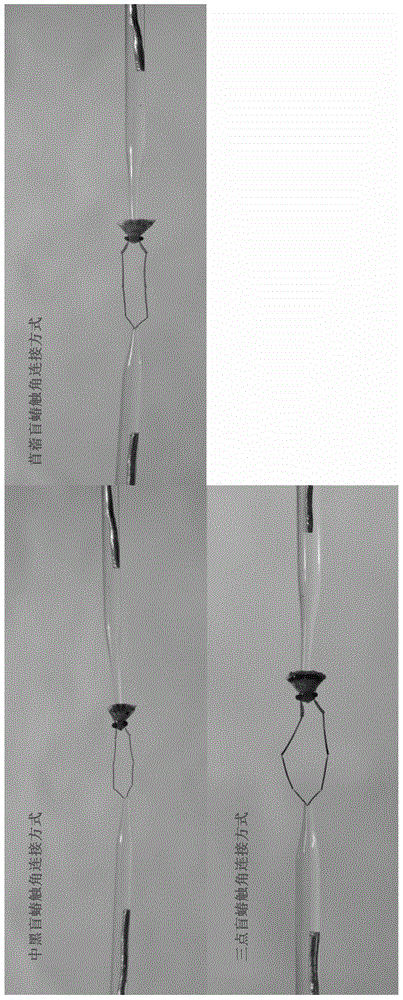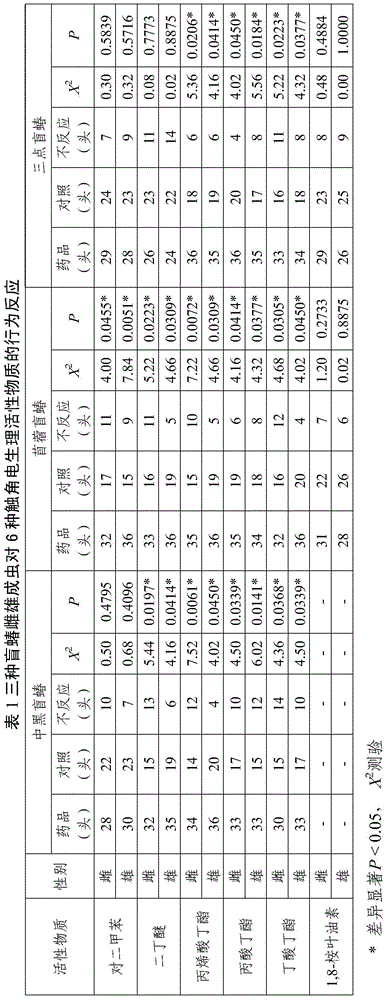Botanical attractant of three kinds of fleahoppers as adelphocoris lineolatus
A technology of Lygus clover and attractant, which is applied in the direction of attracting pests, plant growth regulators, animal repellants, etc., can solve the problems of reducing the use of chemical agents, reducing the population number, and increasing harm
- Summary
- Abstract
- Description
- Claims
- Application Information
AI Technical Summary
Problems solved by technology
Method used
Image
Examples
Embodiment 1
[0020] Embodiment 1: the collection of field host plant volatile matter
[0021] When the main host plants of three kinds of mirid bugs such as cotton in the field are in full bloom, use a polyethylene fresh-keeping bag (40cm×60cm) to cover the flowering part to collect volatiles. Tube( 3350 silicone, USA), wrapped with scotch tape for airtightness, an air inlet pipe was inserted into the lower opening, wound and fixed on the plant with tape, the air inlet and outlet silicone pipes were connected to the outlet and outlet of the atmospheric sampler (Beijing Labor Protection Research Institute) respectively. At the inlet, the air in the intake silicone tube is filtered by activated carbon and enters the fresh-keeping bag, and the air with plant volatile gases is absorbed by the 40mg adsorbent in the adsorption column ( Type Q 80-100Mesh, Bulk Packing Material, Altech Assoc, USA) and return to the air sampler after adsorption. The gas flow rate is 1L / min, and the collection i...
Embodiment 2
[0022] Screening and identification of embodiment 2 active volatile components
[0023] Take a 6-10-day-old mirid bug with a finger tube, distinguish between male and female, and then put them on ice to freeze to faint. Put it under the dissecting microscope with the ventral side up, press the abdomen with an insect needle, and cut off the middle part of the fore leg segment of each species of Lygus quickly with a double-sided blade. After cutting, observe whether the tissue membrane at the part of the head is If the tissue fluid flows out, the membrane is intact and can be tested further; if the tissue membrane is ruptured, it cannot be used and needs to be prepared again. Afterwards, cut off a very small part of the tips of the two antennae, and then use the prepared reference electrode (soaked in 0.9% NaCl solution in the capillary) to align with the tissue membrane at the incision and gently insert it slightly lower and not If the insertion is too deep, stop when you feel...
Embodiment 3
[0027] Embodiment 3 olfactory behavior response
[0028] Before the test, the female and male adults of a single Lygus were starved for 4 hours (only a cotton ball dipped in pure water was provided during the period), and then used for the behavioral measurement of the Y-type olfactometer. The 5ml centrifuge tube (cut off at the bottom) connected to one tube arm of the Y-shaped olfactometer contains the slow-release material with 20 μl of active substance standard (concentration: 100 mg / ml) dropped; the centrifuge tube connected to the other tube arm contains dropwise added 20 μl of slow-release material for control paraffin oil. The gas flow rate was set at 0.4 L / min. Release a female or male mirid bug into the base arm of the Y-shaped tube for observation, and start timing when the mirid bug is at 2 / 3 of the base arm. Judging according to the following criteria: within 3 minutes, when the mirid bugs crossed any tube arm 3cm and stayed in this area for more than 5s, it was ...
PUM
 Login to View More
Login to View More Abstract
Description
Claims
Application Information
 Login to View More
Login to View More - R&D
- Intellectual Property
- Life Sciences
- Materials
- Tech Scout
- Unparalleled Data Quality
- Higher Quality Content
- 60% Fewer Hallucinations
Browse by: Latest US Patents, China's latest patents, Technical Efficacy Thesaurus, Application Domain, Technology Topic, Popular Technical Reports.
© 2025 PatSnap. All rights reserved.Legal|Privacy policy|Modern Slavery Act Transparency Statement|Sitemap|About US| Contact US: help@patsnap.com



